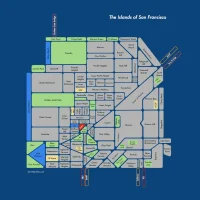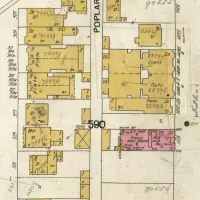The Willows & 18th St. Ravine in 3D and 1860s Mission Amusements
We’ve all seen the classic shot of the Willows, a 19th century Mission beer parlor between what would be Mission and Valencia on 18th:
I’ve previously written about the Willows and the 18th St. Gulch (aka Gulchie, the Valencia St Hotel eating monster). But architect Glen Lym has taken it to the next level. You know those contour lines on the 1853 and 1859 US Coast Survey maps I traced in such brutalist fashion?
Our esteemed architect has taken the map into THE THIRD DIMENSION and made a freakin’ CAD model of 1850s San Francisco. Looking northeast:
Here we are looking west at the Willows, with Mission Dolores and Twin Peaks in the background (along with what will become Dolores Park):
Modern streets are overlaid on the map. To the right of the Willows is 18th. The street in front is Mission, then San Carlos / Lexington / Valencia. Glen notes, “Funny that The Commonwealth restaurant now sort of sits on top of where The Willows used to be.”
A lower view to give you a better sense of the depth of the ravine:
and its proximity to Mission Creek.
Here’s an overview of the Mission, looking north, from above 24th and South Van Ness.
The dunes that Market St had to cut through are quite evident at the top of the picture. The big flat area in the forground was the home to the Union Race Course.
It’s hard to grasp the size of the Mission’s ravines — the best analogy I can come up with is to stand at 27th and Guerrero and look north towards Cesar Chavez. Imagine twice the depth in half the distance.
Man, what I would give to have a beer at the Willows. Here’s an old ad:
(via SFPL)
I can only assume Miss Lotta is the fountain‘s namesake, Lotta Crabtree.
But wait — skating and beer?!‽ (Ocean Beach, I just topped your ghost ice rink.) The Willows was evidently run by Canadians. (Seriously, Canadian-San Franciscans, let’s get a new rink in the Mission. Or at least a street hockey game as a float in the Carnaval parade. That would be pretty sweet.)
Via the California Digital Newspaper Archive we find some more ads for the Willows.
1857 – new shells walks! Hansome summer houses! All kinds of refreshments!
Notice the omnibus references — It looks like this ad was announcing the opening of the omnibus line from downtown. (Previously you had to get out at the Nightingale on Mission and 16th – a little more on that area here.)
(via SFPL)
The Willows was popular with the ladies — in the Daily Alta’s gossip column we see the shocking news of a FEMALE equestrian who rode to the Willows!
(I guess she got fined for the modern equivalent of drag racing — considering inflation, that $20 in 1857 is like $500 today.)
Getting to the Willows could be hard work — here we have the tale of “clerks” drunk driving on the plank road (maps and pix here) and not quite making it there:
The Willows was also a place of refuge for newsman having a bad day:
Best to stick to the Omnibus for 25 cents (aka $6 today)
(Ha, “the benefits to be derived are too well understood to need any comment at this time” — I am so using that at work.)
In addition to beer, the Willows also had “barbacue”:
(How can you not have a grand time with beer and BBQ?)
It looks like the Willows got a new owner in 1860, François Pioche, who actually built the Market Street Railway. (I had no idea how much SF infrastructure he financed — how does he not have a street named after him?) Anyway, he made the Willows all fancy.
Here in this 1860 ad, we hear about the massive upgrade to the Willows — I suspect this is the building we see in the picture at the top of this increasingly long article. Kitchens! Private saloons! And wait for it…not one, but TWO BOWLING ALLEYS:
The great flood of 1862 (24 inches of rain in one month) hit San Francisco hard — the Mission plank road washed out, the road to San Jose was impassable, a Mission Woolen Mills storage building collapse, 8-10 feet of water in basements downtown, and Mission Creek flooded the Willows:
They quickly rebuilt:
I get the feeling the early 1860s was the heyday of the Willows. I’m not entirely sure when the it shut down, but in 1871 Mark Twain wrote of “the dingy horrors of San Francisco’s pleasure grove, the Willows.” That can’t be good.
Thanks again to Glen Lym and his 3-dimensionality! Also check out Bernalwood’s analysis of the missing hills of Bernal.






























Excellent article! There is a Pioche Street just south of Silver, though, so he does have his monument.
He needs a longer street!
By the way, you might want to mention Assessor’s Map B229, the subdivision of the Willows Land Association (August 12, 1870). I miss living in the Willows.
Man, I wish they had the traces for the Willows building itself on that map.
Rally neat, wonderful to get the “color” of these places and what they were to the people who lived there at that time. Seeing as I’m Chinese, I wonder what “Celestrial Wash House” was in that Willows ad. Given that Celestial was the term for Chinese, they must have had an on premises chinese laundry. My great grandfather immigrated to San Francisco when he was 12 years old, landing here around 1857. And my grandfather, with whom I grew up with in Berkeley, was born in Dogpatch in 1883. I would guess if they allowed Chinese in, it would have been through the “Celestial” entrance! I note that there is discussion of the Willows offering patronage to “the respectable portion of the community”. Ah and I used to think that the Willows was just a drinking place, maybe the Zeitquiest of its day…
I too lived in the Willows in ‘nought five for a couple years. It is really central to lots of good stuff in the mission. I’m wondering if, like Woodward’s Garden, a hip restaurant will open up in that area and name itself after its ancestor.
What a great article! Thank you for all your research.San Francisco & Bay area victorian leisure places are fascinating.
My Irish great grandparents arrived in the City in 1870. Living all over South of the Slot till 1880. In 1880 they bought a house in 29th near Sanchez. Trades in that family where: Stone mason, cement mason, & tailoress. My English bunch arrived 1886: 3 generations all together Their trades, brick mason, builders, contractors, paving, plasterers. From 1886 to 1898: lived 1st st., Dolores, Santa Clara st, Elgin Park st, Duncan near Sanchez to name a few. Finally in 1898 buying a set of flats on 17th st , 3 blocks fown from Castro. 1 great great grandad (1890)& his daughter (1896)buried in the I.O.O.F. Cemetary where Rossi Park is.All 5 sons stayed in S.F. too. I was born in the City ,1951& grew up in the Excelseior District. In a house that had been a 20’x20’barn prior to 1906. I sold that house & moved to Montara in 1979. Yet my ties to the City did not end there: I was a City Gardener in G.G.P. for 27 years!
Will read all your writings & pass them to a 1st cousin: another Native of S.F.
Thank you, Lily Holsworth